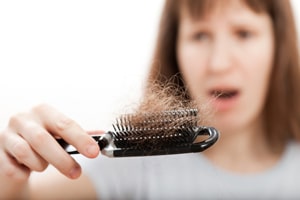January 8, 2018
A Look At Alopecia Areata
By Michael D. Shaw
We get some basic information from the National Alopecia Areata Foundation. This is a fairly common autoimmune skin disease—affecting around 6.8 million people in the US, with a lifetime risk of 2.1%. The condition crosses all ethnic groups, affects both sexes, and hits folks of all ages, often first appearing during childhood. There is wide variability in how the disease progresses.
Simply put—for reasons not well understood—the immune system attacks healthy hair follicles, causing them to become much smaller and drastically slow down production to the point that hair growth may stop. Hair loss can occur in different areas of the body, along with regrowth, in a manner that can be unpredictable and cyclical over a period of months or years. The good news is that unlike other forms of baldness, in alopecia areata, the hair follicles do not die, and hair can regrow at any time.
Sufferers might also experience symptoms in fingernails and toenails whereby they can become pitted or stippled—appearing as if a pin had made dents in them. A sandpaper-like texture can also occur.
Three main types of the disease are identified:
** Alopecia areata patchy—The most common form, with one or more coin-sized hairless patches on the scalp or other areas of the body
** Alopecia totalis—Total loss of the hair on the scalp
** Alopecia universalis—Complete loss of hair on the scalp, face, and body
It is worth noting that more than 80 autoimmune diseases have been identified, such as type 1 diabetes, rheumatoid arthritis, systemic lupus erythematosus, and inflammatory bowel disease. Official statistics peg the number of autoimmune disease sufferers in the US at 23.5 million, although some suggest that the figure is more like 50 million.
Conventional treatment options for alopecia areata include oral and injectable corticosteroids, topical Minoxidil, Anthralin cream or ointment, and topical immunotherapy. However, since hair usually grows back within a year, and treatment might produce unpleasant side effects, some patients do not seek therapy, and may instead opt for a hairpiece, or simply go natural.
A promising new therapy involves the use of immunmodulators—specifically, Janus kinase (JAK) inhibitors. By way of background, cytokines are vital in maintaining appropriate immune response. Of particular interest is the JAK-STAT (Janus kinase-signal transducers and activation of transcription) signaling cascade. As such, JAK inhibitors are drugs that inhibit the kinase activity (adding phosphate groups) of JAK.
FDA approved compounds (but not yet for alopecia areata) in this class are Ruxolitinib, Tofacitinib, and Oclacitinib. Clinical trials targeting alopecia areata are ongoing with Ruxolitinib and Tofacitinib, and show generally positive results. One drawback is that these drugs are extremely expensive, with Tofacitnib being somewhat less so.
At the American Academy of Dermatology Annual Meeting in March, 2017, noted Yale researcher Brett King, MD, PhD said that JAK inhibitors “are going to change how we think about what we do.” His group is responsible for two studies published in January, 2017—both with encouraging results. (Ref 1 Ref 2) King predicted that a JAK inhibitor will be approved for the treatment of moderate to severe eczema in two years, and for the treatment of moderate to severe alopecia areata in two to three years.
Also in January, 2017, seven-year-old Gianessa Wride of Salem, Utah lost all of her hair in 20 days due to alopecia areata. Headscarves didn’t stay in place, wigs were uncomfortable, and the school’s “Crazy Hair Day” was coming up in March. What to do? Her mom decided to decorate the little girl’s head with adhesive jewels and glitter. Gianessa won first place!
She told People magazine: “I was sad at first when I lost all my hair, but now I love being bald. I can do things to my head that other kids can’t. I’m thinking now it might be fun to decorate my head with some sparkly butterflies and flowers.” How’s that for body positivity?

